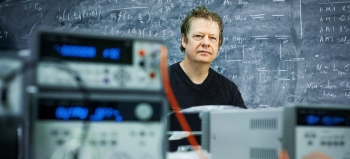Jul 4 2013
One year after discovery, Prof. Colin Gay describes how Canadian scientists helped sort through mountains of data to help pinpoint the particle
 Colin Gay is one of several UBC scientists who played a part in the discovery of the Higgs boson. Martin Dee photograph
Colin Gay is one of several UBC scientists who played a part in the discovery of the Higgs boson. Martin Dee photograph
The discovery of the Higgs boson was without doubt the most important of its kind in recent years. Finding the subatomic particle at the Large Haldron Collider (LHC) on the Swiss-French border made international news earlier this year—and for good reason.
It affirmed 40 years of physics in support of the so-called Standard Model, our best current description of the basic particles that make up the universe. Had it not been found, doubt would have been cast on an unthinkably broad swath of modern science – calling into question our understanding of everything from how a laser works to how a molecule stays together to what’s going on inside your cell-phone.
Colin Gay, a professor in UBC’s Department of Physics and Astronomy who led a Canadian team of researchers that contributed to the discovery of the Higgs boson, says the recent breakthrough is “just the beginning.”
To understand the significance of the discovery, the role of Canada and UBC, and why physicists are careful to qualify it with terms like “probable” and “Higgs-like,” it’s necessary to look a little deeper into what goes on at the LHC, and what the findings mean for modern particle physics.
How the LHC Works
The LHC throws hydrogen atoms at each other at enormous energies—they’re travelling so fast that if they raced a beam of light from here to Neptune the atoms would lose by only about 12 milliseconds. These atoms are smashed into each other, packing so much energy that they actually create new particles as per Einstein’s famous equation E(nergy)=m(ass)c^2. Unfortunately, most of the particles created in this way are boring; millions of particles long known to physicists come streaming out of the LHC each second, while a Higgs boson might be created once a month.
To make matters worse, the Higgs boson lives for such a short time that it never makes it to even the closest of detectors. Physicists have to infer its existence by looking at changes in the number and type of the otherwise boring particles they detect directly, rather like a police investigator narrowing in on a major financial malfeasance by following a trail of otherwise ordinary purchases. It takes huge amounts of data, analysis, and re-analysis for physicists to be sure that the particles they did see actually came from the Higgs boson.
Canadian profs help sift through all the data
Sorting out all this data to find the important parts is possible thanks to Gay and his group at UBC. They built the Data Acquisition System (DAC) for ATLAS, one of two detectors at the LHC. The DAC is a set of custom made electronics that can look at the enormous flow of data coming in and pick out the pieces worth keeping.
“ATLAS produces one typical hard drive’s worth of data each second,” says Gay. There’s no way even the prodigious computers at CERN could store or transmit that much data, so the DAC sorts it before it even gets to the computers, throwing out the vast majority of it, while keeping anything that could be of interest.
Canada also has a large role in processing the data. The national accelerator laboratory, TRIUMF, houses a fantastically powerful computer centre dedicated to analyzing the huge amount of data produced, and is one of only ten such “Tier 1” centres in the world.
When the LHC, which is currently offline while upgrading some components, comes back on in 2015, it will be at twice the energy it was running when it discovered the Higgs. Higher energies allows physicists to look at both new particles and smaller lengths—the new energy will be probing phenomena a billion times smaller than an atom. The new data coming out of ATLAS and analyzed in Canada could address mysteries such as dark matter and extra dimensions—things that do not appear at all in the Standard Model.
“I’m fully comfortable saying there’s more than the Standard Model out there,” says Gay.
The situation now, says Gay, is comparable to that in 1900, when it was believed that essentially all of physics was known, except for a few minor problems. Those minor problems turned out to be gateways into new paradigms that changed both our understanding of the universe and our everyday lives. Today’s “minor problems,” such as dark matter, might similarly be hiding realms of new understanding.